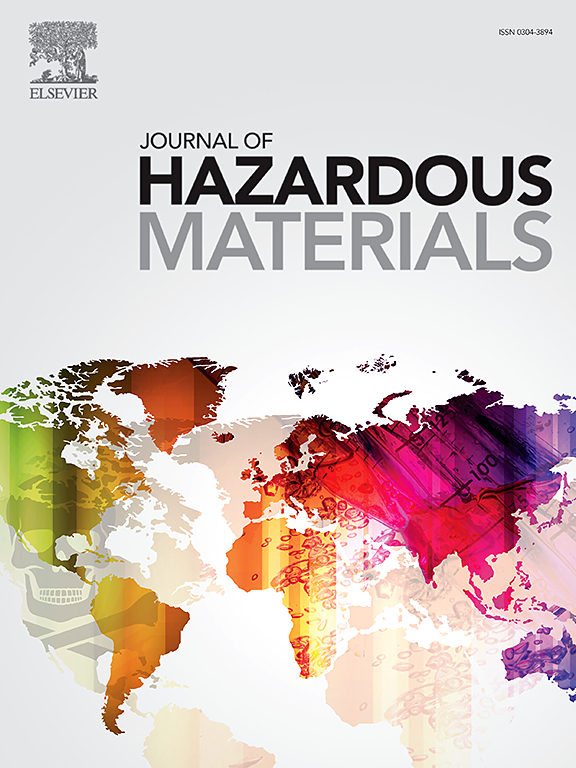Electrochemiluminescence and Fluorescence Dual-Mode Monitoring of Aflatoxin B1 Production Based on Single Ru-MOF Particles and FITC Luminophores
IF 12.2
1区 环境科学与生态学
Q1 ENGINEERING, ENVIRONMENTAL
引用次数: 0
Abstract
Herein, an electrochemiluminescence (ECL) and fluorescence (FL) dual-mode imaging biosensing platform was developed for onsite and dynamic monitoring of aflatoxin B1 (AFB1) production in the corn molding process. Zinc metal organic framework structures encapsulated with Ru(bpy)32+ (Ru-MOF) were employed as ECL signal probes for single particle imaging with stable luminescent intensity and high emission efficiency. Fluorescein Isothiocyanate (FITC) luminophores, served as fluorescent probes, were conjugated with AFB1 aptamer modified on the electrode surface, which enabled the observation of green luminescent spots in FL mode. When exposed to target AFB1, FITC luminophores detached from the surface of electrode, leading to a notable decrease in the number of green luminescent spots. Single Ru-MOF particles were then immobilized onto the surface of electrode through DNA coupling and discernible luminescent spots could be watched in ECL mode. Under optimal circumstances, a dual-mode imaging platform was constructed for AFB1 determination with a linear relationship of 1.0 fg/mL to 1.0 pg/mL in both ECL and FL mode. The detection limit (LOD) was 0.89 fg/mL in FL mode and 0.84 fg/mL in ECL mode, which demonstrated superior sensitivity. The imaging biosensor was established for dynamic tracking of AFB1 production in corn molding process. The results showed that aflatoxin production occurred more rapidly at damaged areas of the corn compared to areas with intact surfaces. The intact corn got moldy on the third day and its surface AFB1 concentration was calculated as 14.16 fg/mL. Combining the ECL and FL imaging technology with dual-mode biosensing, this work achieves high sensitivity, accuracy and capability of dynamic monitoring for AFB1 sensing which provides innovative ideas for the rational design of aflatoxin sensors, and holds substantial promise in food safety.

基于单个 Ru-MOF 颗粒和 FITC 发光体的黄曲霉毒素 B1 产量电化学发光和荧光双模式监测系统
本文开发了一种电化学发光(ECL)和荧光(FL)双模式成像生物传感平台,用于现场动态监测玉米成型过程中黄曲霉毒素 B1(AFB1)的产生。采用 Ru(bpy)32+ 封装的锌金属有机框架结构(Ru-MOF)作为单颗粒成像的 ECL 信号探针,具有稳定的发光强度和较高的发射效率。异硫氰酸荧光素(FITC)发光体作为荧光探针,与修饰在电极表面的 AFB1 合体共轭,可在 FL 模式下观察到绿色发光点。当暴露于目标 AFB1 时,FITC 发光体从电极表面脱离,导致绿色发光点数量明显减少。然后通过 DNA 耦合将单个 Ru-MOF 颗粒固定在电极表面,在 ECL 模式下可观察到明显的发光点。在最佳条件下,构建的双模式成像平台在 ECL 和 FL 模式下测定 AFB1 的线性关系为 1.0 fg/mL 至 1.0 pg/mL。在 FL 模式下,检测限(LOD)为 0.89 fg/mL,在 ECL 模式下为 0.84 fg/mL,灵敏度极高。建立的成像生物传感器可用于动态跟踪玉米成型过程中 AFB1 的产生。结果表明,与表面完好的区域相比,玉米受损区域的黄曲霉毒素产生速度更快。完整的玉米在第三天发霉,其表面的 AFB1 浓度被计算为 14.16 fg/mL。这项工作将 ECL 和 FL 成像技术与双模生物传感技术相结合,实现了高灵敏度、高准确度和高动态监测能力的 AFB1 传感,为合理设计黄曲霉毒素传感器提供了创新思路,在食品安全领域大有可为。
本文章由计算机程序翻译,如有差异,请以英文原文为准。
求助全文
约1分钟内获得全文
求助全文
来源期刊

Journal of Hazardous Materials
工程技术-工程:环境
CiteScore
25.40
自引率
5.90%
发文量
3059
审稿时长
58 days
期刊介绍:
The Journal of Hazardous Materials serves as a global platform for promoting cutting-edge research in the field of Environmental Science and Engineering. Our publication features a wide range of articles, including full-length research papers, review articles, and perspectives, with the aim of enhancing our understanding of the dangers and risks associated with various materials concerning public health and the environment. It is important to note that the term "environmental contaminants" refers specifically to substances that pose hazardous effects through contamination, while excluding those that do not have such impacts on the environment or human health. Moreover, we emphasize the distinction between wastes and hazardous materials in order to provide further clarity on the scope of the journal. We have a keen interest in exploring specific compounds and microbial agents that have adverse effects on the environment.
 求助内容:
求助内容: 应助结果提醒方式:
应助结果提醒方式:


